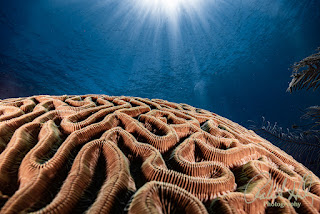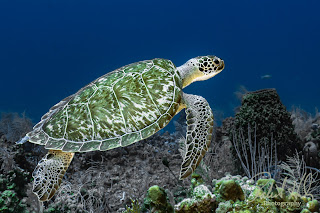Lightroom for Underwater Video: What Works (and What Doesn’t) in 2025
🎥 When Photos Start Moving
Every diver knows that magical moment: you're slowly descending past 30 feet when suddenly, a graceful turtle glides effortlessly past you, or a vibrant school of jacks spirals into the shimmering sunlight above. Instinctively, you hit the record button, capturing that fleeting beauty. But later, when you review the footage back on the surface, it often appears flat, green, and dull, lacking the vibrancy you experienced underwater.
Many Oceanic Explorers face this common challenge, wondering how to bring their underwater footage back to life. The good news is that Lightroom offers powerful tools to enhance your footage, but the best approach depends on which version you're using. Whether you're working with Lightroom Classic or Lightroom CC, understanding the features available can make a significant difference in achieving more vibrant, captivating results.
So, let's explore some tips and techniques to help you unlock the full potential of your underwater recordings and share the true beauty of your dives.
🌊 Lightroom's Video Capabilities — 2025 Overview
Lightroom has experienced significant growth over the years, transforming from a platform focused solely on photos into a versatile, multi-format ecosystem that caters to a wide range of creative needs. Today, all three versions, Lightroom Classic, Lightroom (Cloud), and Lightroom Mobile, offer different approaches and capabilities for handling video. Understanding these differences is essential so you can make the most of each version's features.
Let's take a closer look at what each can do, and, just as importantly, what they can't, to ensure you're fully equipped before you start working with your videos.
1️⃣ Lightroom Classic (v14.5.1 and later)
Classic remains the powerhouse for still photographers, but it treats video like a guest rather than a resident.
This highlights its core strength in capturing still images, which has long been its primary focus and area of expertise. However, when it comes to video, the platform gives it only passing attention, treating it more as an occasional visitor than as an integrated part of its ecosystem. For photographers who primarily deal with static images, this approach works well. Yet for those looking to seamlessly blend still photography with video content, this may be limiting, suggesting that video isn't yet entirely woven into its fabric.
As technology and content creation evolve, it will be interesting to see if Classic keeps its stronghold in still photography while expanding its capabilities to better serve the growing demand for integrated multimedia workflows.
You can:
-
Import
.MP4,.MOV, and.AVIclips into your catalog. -
View and trim them in the Library module.
-
Set a poster frame (thumbnail) for better catalog organization.
-
Use Quick Develop for limited global corrections (Exposure, Contrast, White Balance).
-
Extract still frames (
Ctrl/Cmd + Alt + Shift + E) and apply Develop edits to those. -
Export trimmed MP4 files — though this works best with short, simple clips.
You cannot:
-
Open videos in the Develop module.
-
Use masking, local brushes, Curves, or Point Color.
-
Apply AI Denoise or other advanced tools to moving footage.
💡 Pro Tip: Use Classic to organize, trim, and color-sync short clips, then pass them to Lightroom (cloud) or Photoshop for deeper grading.
2️⃣ Lightroom (Cloud Desktop v8.5.1 and newer)
Here's where the magic happens.
The cloud-based version of Lightroom now lets users perform actual video editing directly within the application. This feature is integrated into the same user interface used for photo editing, providing a seamless experience for those working with both images and videos.
You can:
-
Import
.MP4and.MOVclips. -
Trim and scrub playback easily.
-
Adjust Exposure, Contrast, Highlights, Shadows, and White Balance.
-
Fine-tune Color (Hue, Saturation, Luminance).
-
Apply Presets and Profiles, including custom underwater Presets and Profiles.
-
Export in MP4 (H.264) up to 4K.
These adjustments are considered global, meaning they influence the entire clip rather than just specific sections. While tools like Local Masking, Curves, and AI Denoise are mainly designed for still photos, Lightroom's video features have come a long way. For quick underwater corrections, these video tools now deliver surprisingly cinematic results, enabling efficient enhancements without complex editing workflows.
🎓 Why it matters: You can now color-correct a GoPro turtle clip, add warmth to a shallow coral swim-through, and share directly to Instagram, all without leaving Lightroom.
3️⃣ Lightroom Mobile (v10.5 and newer)
Editing video from your phone or tablet has never been smoother.
Lightroom Mobile offers nearly the same toolset as Lightroom Desktop, minus a few desktop-only export and sync options.
You can:
-
Import clips from your camera roll or housing app (Kraken, SeaLife, AxisGO).
-
Trim your footage.
-
Adjust Light, Color, and Effects panels just like with photos.
-
Apply Adaptive Presets (like Underwater Vibrance).
-
Export vertically (9:16) for Reels, Stories, or TikTok.
You cannot yet use:
-
AI Masking or Point Color on video.
-
Separate audio editing or frame stabilization.
💡 Oceanic Explorer Tip: Do your color correction right after the dive, when your memory of the reef colors is fresh. It'll help you match the authentic tones you saw underwater.
⚙️ Step-by-Step: Underwater Video Workflow Using Lightroom Ecosystem
Step 1: Import and Organize
-
Classic: Import (
Cmd/Ctrl + Shift + I) into your dive catalog. -
Cloud: Drag directly into Lightroom; clips auto-sync to your devices.
-
Mobile: Use "Add Media" to pull clips from your phone or housing app.
Tag by dive site, depth, and subject, e.g., "Roatan_Turtle_10m", for later searchability.
Step 2: Trim for Impact
-
Use the Trim Handles at the clip edges to isolate the best 5–15 seconds.
-
Cut out shake, sediment clouds, or fin kicks before you begin color work.
🎬 Keep social clips short, under 20 seconds, perform best on IG and FB Reels.
Step 3: Correct Exposure and Color
In Lightroom (cloud or mobile):
-
Tap Light ➜ Raise Exposure slightly (+0.3 to +0.5).
-
Lower Highlights (–20) to tame sunlight streaks.
-
Lift Shadows (+40) to recover dark coral details.
-
Open Color Panel ➜ Warm Temp (+400–800) and add Magenta Tint (+10).
-
Adjust Vibrance (+20) for coral tones without oversaturation.
🎓 PhD Insight: When it comes to underwater video color grading, the key is achieving a balanced look that enhances the natural beauty of the scene. Focus on recovering the reds to add warmth and life to your footage, but do so with care; overdoing it can look unnatural. Simultaneously, pay attention to blue luminance to convey depth and immersion.
Remember, subtlety is your best friend here; avoid excessive saturation boosts, which can lead to a noisy or overly processed appearance. Instead, aim for a refined, balanced look that feels natural and engaging, highlighting the underwater environment without sacrificing realism.
Step 4: Add Style and Export
-
Apply your Underwater Preset or Profile for consistency.
-
Tap Crop ➜ 9:16 for vertical Reels.
-
Export in MP4, 1080p, 30–60fps, H.264 codec.
-
Add a title card or watermark if desired (Photoshop or Premiere).
📊 Feature Compatibility Chart – 2025 Edition (Updated)
| Feature | Lightroom Classic | Lightroom (Cloud) | Lightroom Mobile | Photoshop / ACR |
|---|---|---|---|---|
| Import MP4 / MOV | ✅ | ✅ | ✅ | ✅ |
| Trim Clip | ✅ (Library) | ✅ | ✅ | ✅ |
| Exposure / WB / Color | ⚠️ (Quick Develop) | ✅ | ✅ | ✅ |
| Local Masks / Curves | ❌ | ❌ | ❌ | ✅ |
| Presets / Profiles | ✅ | ✅ | ✅ | ✅ |
| AI Denoise | ❌ | ❌ | ❌ | ✅ (Still Frame) |
| Export MP4 (H.264) | ⚠️ (Limited / Conditional) | ✅ | ✅ | ✅ |
| Sync to Cloud | ✅ (via Smart Previews) | ✅ | ✅ | ✅ |
✅ = Supported ⚠️ = Limited / Conditional ❌ = Not Supported
⚠️ Clarification for Lightroom Classic Users
While Lightroom Classic can export MP4/H.264 files using the Export dialog (the same way as photos), this function remains limited and occasionally unstable. It works best for short clips or basic trims processed in the Library module.
However:
-
Edits made to extracted stills do not carry over dynamically to the moving footage.
-
Long-form or high-bitrate videos (especially 4K HDR) often stall during export.
-
The Slideshow module remains the most reliable way to output MP4 video from Classic (useful for sequences or still-based slideshows).
For full-resolution underwater video editing, color grading, and consistent export reliability, Lightroom (cloud) and Lightroom Mobile remain the best choices within Adobe's ecosystem.
🧠 Pro Tips for Oceanic Explorers
-
🎞 Capture Flat: Use "Flat" or "Natural" color profiles on GoPro for better editing range.
-
📱 Mobile First: Quick edits immediately after the dive help you preserve actual color memory.
-
🪶 Keep it Real: Subtlety beats saturation. Aim for "cinematic natural," not "neon reef."
-
☁️ Use Sync: Start a clip edit on your phone, then fine-tune it later on your laptop, same cloud catalog, no exporting required.
🌊 Why This Workflow Matters
For many years, Lightroom was primarily recognized as a dedicated environment for photo editing and management. However, the 2025 Lightroom ecosystem introduces a new era for underwater photographers and videographers alike. It now enables users to manage, trim, and color-correct videos directly within Lightroom, eliminating the need for heavy, complex software or steep learning curves.
Although Lightroom Classic doesn't yet offer complete Develop control for videos, combining its robust organization and cataloging capabilities with the powerful new video editing tools available in Lightroom Cloud and Mobile creates a truly seamless, cross-platform workflow.
This integration reduces the time spent switching between programs, freeing you to focus more on your creative pursuits and, of course, spend more time diving into your next adventure.
📌 Learn More + Get Involved
-
📘 Read the full guide at: info.robertherb.com/lm-2-blog
-
🎥 Share your color-graded clips using #RobertHerbPhotography
-
📩 Questions or training requests? Contact me at bob@robertherb.com
Until next time, dive smart, shoot steady, and edit with intention. - Bob Herb
🧭 What's Next?
🟦 Have you tried any of these techniques yet? Share your edits using #RobertHerbPhotography.
🟦 Want to see these workflows in action? Sign up for my upcoming training course at RobertHerb.com or reach out at bob@robertherb.com
🟦 And don't forget, new blogs drop weekly at Robert Herb Photography Blog
Written by Robert Herb – Empowering underwater photographers to capture and enhance the beauty of our oceans since 1978
Stay tuned for more in-depth insights into underwater photography. Let's dive deeper into the art and craft of capturing the marine world! If you have any comments or suggestions, I'd love to hear them.
Get ready for an exciting underwater photography adventure! For more details on my upcoming online training course, check out my "Training" page at RobertHerb.com or email me at bob@robertherb.com.
Sincerely,
Bob Herb
|
|





Comments
Post a Comment
Please let me know your comments.